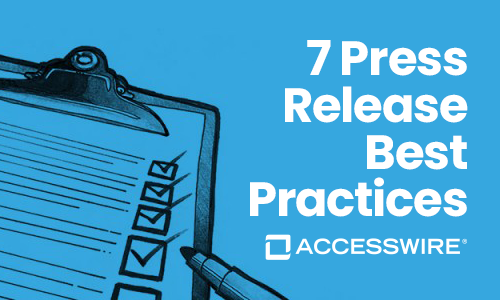Tips on How to Cite a Press Release
Press releases are one of the top resources journalists rely on to find new stories, and it makes sense why1. Press releases succinctly detail the who, what, when, where, and why of any story, whether it’s the release of a new product, the announcement of a merger, or the results of scientific research. This makes press releases an invaluable source of information—not only for journalists but also for businesses looking to provide their customers with new and exciting information that relates to their products or services.
However, if you’re drawing information from a press release, you’ll want to ensure you properly cite that press release. This demonstrates to your readers that your information is derived from a credible source and gives them the opportunity to explore that source further if they’re interested in learning more.
There are several different formats you can use when citing a press release for a new business. In this article, we’ll break down the distinguishing features of these press release templates and formats, as well as discuss everything you need to know about how to cite a press release.
Press Release Citations
When citing a press release for an event, you’ll always include the following elements: the author, title, date of publication, and source (in other words, where you found the press release). However, your citations will vary slightly depending on what style of formatting you use. The most common styles are APA, MLA, and Chicago.
So, let’s discuss tips for how to properly cite a press release using each of these styles.
APA Style
The American Psychological Association or APA style is traditionally used when formatting and citing sources within the field of social sciences, such as psychology and sociology. When using this format, your citation should include:
- Author – Your citation should list the author’s last name first, followed by a comma and the first name. However, because press releases are typically written and published by organizations, your author will likely be the organization.
This means you’ll want to start your APA citations with the name of the company. If a specific department within an organization released your particular press release, you should list the organization first, then list the specific department. - Date of publication – The date of publication should be listed in your citation within parentheses. It should follow this format: year, month, and day (written in numerals).
- Title – When you cite the title of your press release, be sure to italicize it. Further, you should only capitalize the first word, along with any proper nouns (even if the title of the press release is written in title case).
To clarify that you’re citing from a press release, you should also include the words “Press release” in square brackets after the title but before the punctuation. Unlike the title, the identifier “press release” should not be italicized. - Source – The final piece of information in your citation should be your source. For press releases, this will typically be a website. Introduce your source with the words “Retrieved from.”
APA style citations should also be formatted so that all lines following the first line are indented.
In-Text Citations in APA Style
While your full APA citation will appear in your reference list at the end of your document, you can also include in-text citations when referencing specific information from your press release, such as a quote. The in-text citation is another area where you’ll notice a difference between the various styles of citation. With the APA style, your in-text citation will include the author of the press release, followed by the year of publication.
Examples of APA Style Citations
Let’s take, for example, a press release published by the Society for Personality and Social Psychology that details new research regarding how men can impact gender equality in the workplace. Your citation of this press release in your reference list should look like this:
Society for Personality and Social Psychology. (2021, August 09). New research reinforces impact
men can have as gender equality allies in the workplace [Press release]. Retrieved from https://www.spsp.org/news-center/press-releases/new-research-reinforces-impact-men-can-have-as-gender-equality-allies-in-the-workplace.
An in-text citation of this press release should look like this:
(Society for Personality and Social Psychology, 2021).
MLA Style
The MLA style refers to the particular style of formatting and citation published by the Modern Languages Association. As such, it’s commonly used when writing in the field of humanities. While this style of citation is similar to the APA style in that it will include the press release’s author, title, date, and source, it expands upon this information and differs in its presentation.
Let’s take a look:
- Author – MLA style citations should begin with the author of the press release. This may be a singular person or an organization. In the case of a singular person, you should list the last name first, followed by the first name.
- Title – Unlike APA, the MLA style parenthetical citation notes the press release title immediately after the author. You should place the title in quotes and type it in standard font. With MLA format, there’s no need to italicize, and the title should be written in title case.
- Name of organization – After the title of the press release, MLA format dictates that the name of the organization be stated, followed by “Press Release.” Rather than punctuating this information with a period, use a comma followed by the date of publication.
- Date of publication – The date of the publication should be written in the following order: day, month (abbreviated if over 5 letters), and year.
- Source – The source of the press release will follow the date of publication.
- Date accessed – To end your MLA citation, you should include the date you accessed the information in the same day, month, and year order as the date of publication.
In-Text Citations in MLA Style
Another distinguishing feature of MLA style is the formatting of in-text citations. To cite your press release within the text of your document, you should write the press release’s author (or organization) and page number (if applicable) within parentheses.
Examples of MLA Style Citations
To better understand the differences between APA and MLA style formatting, let’s cite a press release that announced the donation of more than 16,000 liters of Purell Hand Sanitizer to local hospitals.
In MLA format, your press release references page citation would look like this:
GOJO. “GOJO and Lubrizol Join Together to Donate More than 16,000 Liters of PURELL Hand
GOJO. “GOJO and Lubrizol Join Together to Donate More than 16,000 Liters of PURELL Hand
Sanitizer to Northeast Ohio Hospitals.” GOJO Press Release, 20 April 2020. https://www.lubrizol.com/ Newscenter/ News-and- Insights/2020/ GOJO-and- Lubrizol -Join-Together -to Donate#:~:text= AKRON %2C%20 Ohio %20%2D%2D%20 GOJO %20 and,Hand %20 Sanitizer%20% 2D %20to%20 local %20hospitals. &text=GOJO%20and%20 Lubrizol %20have% 20been,industry%20for%20over %20a%20decade. Accessed 10 Oct. 2021.
An MLA in-text citation of this press release would appear as follows:
(GOJO).
Chicago Style
Chicago style citations, as dictated by the Chicago Manual of Style, are separated into two distinct categories:
- Author-date – The author-date format most closely resembles the APA and MLA styles. It’s distinguished by parenthetical in-text citations that include the press release’s author and publication date and is commonly used when writing in the science or social science space.
- Notes and bibliography – This format is commonly used in the field of humanities. Unlike other styles of citation, this style relies on footnotes, rather than in-text citations.
Let’s take a look at how this style will affect how you cite your press release:
- Author – Like the previous two styles, both Chicago style categories start citations with the name of the author or organization.
- Year of publication – If using the author-date Chicago style, you should include the year of publication after the author’s name. If you’re using the notes and bibliography style, you can omit the date here.
- Title – The title of your press release should be placed in quotes and written in title case, followed immediately by a comma and the full date of publication.
- Date of publication – With author-date format, include the name of the organization before the date of publication as you would with MLA style. With notes format, you should only list the date of publication here, not the name of the organization. The date should appear in the following order: month, date, year.
- Source – To end your Chicago-style citation, include the source of your press release.
In-Text Citations in Chicago Style
As we stated earlier, you’ll only use parenthetical in-text citations if you choose to cite your press release with the author-date style of Chicago formatting. This will include the author of the press release, followed by the year of publication.
Examples of Chicago Style Citations
To see this style of press release citation in action, let’s look at how you’d format a Chevrolet press release announcing the launch of their new Corvette. With the author-date style of Chicago formatting, your full citation would appear like so:
Chevrolet. 2020. “First 2020 Chevrolet Corvette Rolls Off the Line.” Chevrolet, Feb. 03, 2020.
Your in-text citation would appear like this:
(Chevrolet 2020).
If you choose to use the notes and bibliography style of Chicago citation formatting, your footnote citation would look like this:
Chevrolet, “First 2020 Chevrolet Corvette Rolls Off the Line,” Feb. 03, 2020. https://media.chevrolet.com/media/us/en/chevrolet/home.detail.html/content/Pages/news/us/en/2020/feb/0203-corvette.html.
Another format that is often used is the AP or Associated Press style. If you want to learn how to write in this format and other types of press releases, read our guide on AP style press release format and check out our press release example for events.
For All Your News Distribution Needs, Trust ACCESSWIRE
Properly citing a press release can ensure that you or your company uses that press release’s information as effectively as possible. And when you need to write and spread the press release yourself, you’ll want to have an effective press release distribution process as well. That’s where ACCESSWIRE can help.
At ACCESSWIRE, we’re committed to helping you grow your business by ensuring your news reaches your target audience, without costing you a fortune. Request a demo of our press release service today to see how the ACCESSWIRE team can help you reach your news distribution goals.
Sources:
APA Style Blog. How to Cite a Press Release in APA Style.
Bibliography. Difference Between MLA and APA Citation Pages
Business2Community. How to Cite a Press Release.
Similar Blog Posts
PRODUCTS
ACCESSWIRE | All Rights Reserved




